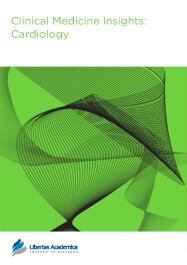

Publication Date: 05 Jan 2012
Type: Original Research
Journal: Clinical Medicine Insights: Cardiology
Citation: Clinical Medicine Insights: Cardiology 2012:6 7-16
doi: 10.4137/CMC.S8578

The Purpose of the Study: Radiofrequency (RF) catheter ablation represents an important advance in the management of children with cardiac arrhythmias and has rapidly become the standard and effective line of therapy for supraventricular tachycardias (SVTs) in pediatrics. The purpose of this study was to evaluate the intermediate term follow up results of radiofrequency catheter ablation in treatment of SVT in pediatric age group.
Methods: A total of 60 pediatric patients (mean age = 12.4 ± 5.3 years, ranged from 3 years to 18 years; male: female = 37:23; mean body weight was 32.02 ± 12.3 kg, ranged from 14 kg to 60 kg) with clinically documented SVT underwent an electrophysiologic study (EPS) and RF catheter ablation at Children's Hospital Mansoura University, Mansoura, Egypt during the period from January 2008 to December 2009 and they were followed up until October 2011.
Results: The arrhythmias included atrioventricular reentrant tachycardia (AVRT; n = 45, 75%), atrioventricular nodal reentrant tachycardia (AVNRT; n = 6, 10%), and atrial tachycardia (AT; n = 9, 15%). The success rate of the RF catheter ablation was 93.3% for AVRT, 66.7% for AVNRT, and 77.8% for AT, respectively. Procedure-related complications were infrequent (7/60, 11.7%), (atrial flutter during RF catheter ablation (4/60, 6.6%); ventricular fibrillation during RF catheter ablation (1/60, 1.6%); transient complete heart block during RF catheter ablation (2/60, 3.3%)). The recurrence rate was 8.3% (5/60) during a follow-up period of 34 ± 12 months.
Conclusion: RF catheter ablation is an effective and safe method to manage children with SVT.
PDF (2.52 MB PDF FORMAT)
RIS citation (ENDNOTE, REFERENCE MANAGER, PROCITE, REFWORKS)
BibTex citation (BIBDESK, LATEX)
XML
PMC HTML

I am impressed by the efficiency at each step of submission in the journal. Based on the first-hand experience, I am confident that this journal will have a great future, and the impact factor will rise rapidly.

All authors are surveyed after their articles are published. Authors are asked to rate their experience in a variety of areas, and their responses help us to monitor our performance. Presented here are their responses in some key areas. No 'poor' or 'very poor' responses were received; these are represented in the 'other' category.See Our Results
Copyright © 2013 Libertas Academica Ltd (except open access articles and accompanying metadata and supplementary files.)
Facebook Google+ Twitter
Pinterest Tumblr YouTube